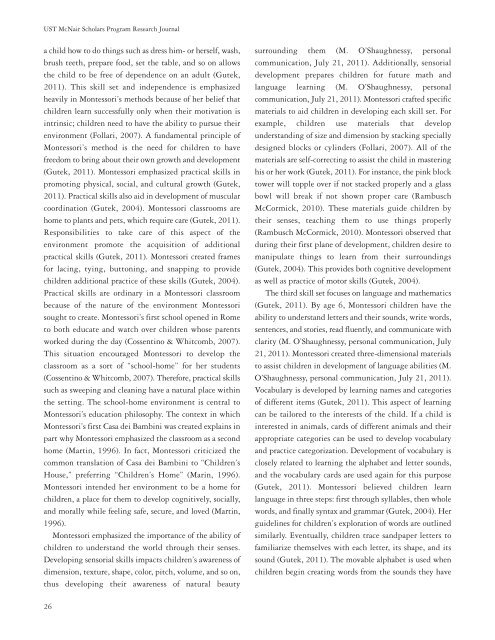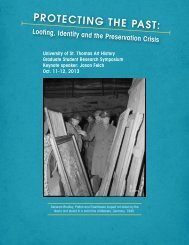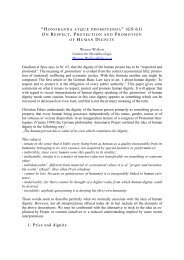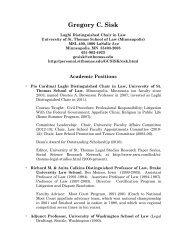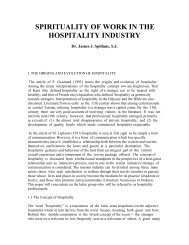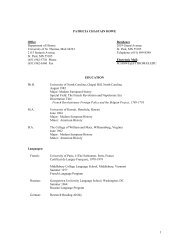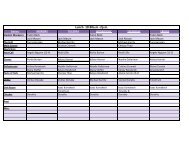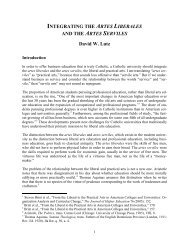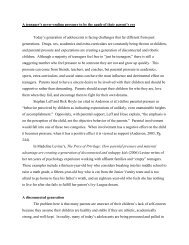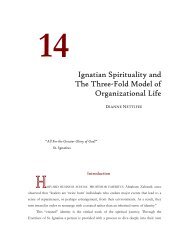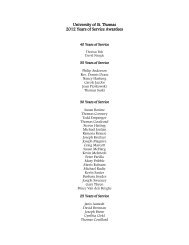dr. ronald e. mcnair acknowledgements - University of St. Thomas
dr. ronald e. mcnair acknowledgements - University of St. Thomas
dr. ronald e. mcnair acknowledgements - University of St. Thomas
You also want an ePaper? Increase the reach of your titles
YUMPU automatically turns print PDFs into web optimized ePapers that Google loves.
UST McNair Scholars Program Research Journal<br />
a child how to do things such as <strong>dr</strong>ess him- or herself, wash,<br />
brush teeth, prepare food, set the table, and so on allows<br />
the child to be free <strong>of</strong> dependence on an adult (Gutek,<br />
2011). This skill set and independence is emphasized<br />
heavily in Montessori’s methods because <strong>of</strong> her belief that<br />
chil<strong>dr</strong>en learn successfully only when their motivation is<br />
intrinsic; chil<strong>dr</strong>en need to have the ability to pursue their<br />
environment (Follari, 2007). A fundamental principle <strong>of</strong><br />
Montessori’s method is the need for chil<strong>dr</strong>en to have<br />
freedom to bring about their own growth and development<br />
(Gutek, 2011). Montessori emphasized practical skills in<br />
promoting physical, social, and cultural growth (Gutek,<br />
2011). Practical skills also aid in development <strong>of</strong> muscular<br />
coordination (Gutek, 2004). Montessori classrooms are<br />
home to plants and pets, which require care (Gutek, 2011).<br />
Responsibilities to take care <strong>of</strong> this aspect <strong>of</strong> the<br />
environment promote the acquisition <strong>of</strong> additional<br />
practical skills (Gutek, 2011). Montessori created frames<br />
for lacing, tying, buttoning, and snapping to provide<br />
chil<strong>dr</strong>en additional practice <strong>of</strong> these skills (Gutek, 2004).<br />
Practical skills are ordinary in a Montessori classroom<br />
because <strong>of</strong> the nature <strong>of</strong> the environment Montessori<br />
sought to create. Montessori’s first school opened in Rome<br />
to both educate and watch over chil<strong>dr</strong>en whose parents<br />
worked during the day (Cossentino & Whitcomb, 2007).<br />
This situation encouraged Montessori to develop the<br />
classroom as a sort <strong>of</strong> “school-home” for her students<br />
(Cossentino & Whitcomb, 2007). Therefore, practical skills<br />
such as sweeping and cleaning have a natural place within<br />
the setting. The school-home environment is central to<br />
Montessori’s education philosophy. The context in which<br />
Montessori’s first Casa dei Bambini was created explains in<br />
part why Montessori emphasized the classroom as a second<br />
home (Martin, 1996). In fact, Montessori criticized the<br />
common translation <strong>of</strong> Casa dei Bambini to “Chil<strong>dr</strong>en’s<br />
House,” preferring “Chil<strong>dr</strong>en’s Home” (Marin, 1996).<br />
Montessori intended her environment to be a home for<br />
chil<strong>dr</strong>en, a place for them to develop cognitively, socially,<br />
and morally while feeling safe, secure, and loved (Martin,<br />
1996).<br />
Montessori emphasized the importance <strong>of</strong> the ability <strong>of</strong><br />
chil<strong>dr</strong>en to understand the world through their senses.<br />
Developing sensorial skills impacts chil<strong>dr</strong>en’s awareness <strong>of</strong><br />
dimension, texture, shape, color, pitch, volume, and so on,<br />
thus developing their awareness <strong>of</strong> natural beauty<br />
26<br />
surrounding them (M. O’Shaughnessy, personal<br />
communication, July 21, 2011). Additionally, sensorial<br />
development prepares chil<strong>dr</strong>en for future math and<br />
language learning (M. O’Shaughnessy, personal<br />
communication, July 21, 2011). Montessori crafted specific<br />
materials to aid chil<strong>dr</strong>en in developing each skill set. For<br />
example, chil<strong>dr</strong>en use materials that develop<br />
understanding <strong>of</strong> size and dimension by stacking specially<br />
designed blocks or cylinders (Follari, 2007). All <strong>of</strong> the<br />
materials are self-correcting to assist the child in mastering<br />
his or her work (Gutek, 2011). For instance, the pink block<br />
tower will topple over if not stacked properly and a glass<br />
bowl will break if not shown proper care (Rambusch<br />
McCormick, 2010). These materials guide chil<strong>dr</strong>en by<br />
their senses, teaching them to use things properly<br />
(Rambusch McCormick, 2010). Montessori observed that<br />
during their first plane <strong>of</strong> development, chil<strong>dr</strong>en desire to<br />
manipulate things to learn from their surroundings<br />
(Gutek, 2004). This provides both cognitive development<br />
as well as practice <strong>of</strong> motor skills (Gutek, 2004).<br />
The third skill set focuses on language and mathematics<br />
(Gutek, 2011). By age 6, Montessori chil<strong>dr</strong>en have the<br />
ability to understand letters and their sounds, write words,<br />
sentences, and stories, read fluently, and communicate with<br />
clarity (M. O’Shaughnessy, personal communication, July<br />
21, 2011). Montessori created three-dimensional materials<br />
to assist chil<strong>dr</strong>en in development <strong>of</strong> language abilities (M.<br />
O’Shaughnessy, personal communication, July 21, 2011).<br />
Vocabulary is developed by learning names and categories<br />
<strong>of</strong> different items (Gutek, 2011). This aspect <strong>of</strong> learning<br />
can be tailored to the interests <strong>of</strong> the child. If a child is<br />
interested in animals, cards <strong>of</strong> different animals and their<br />
appropriate categories can be used to develop vocabulary<br />
and practice categorization. Development <strong>of</strong> vocabulary is<br />
closely related to learning the alphabet and letter sounds,<br />
and the vocabulary cards are used again for this purpose<br />
(Gutek, 2011). Montessori believed chil<strong>dr</strong>en learn<br />
language in three steps: first through syllables, then whole<br />
words, and finally syntax and grammar (Gutek, 2004). Her<br />
guidelines for chil<strong>dr</strong>en’s exploration <strong>of</strong> words are outlined<br />
similarly. Eventually, chil<strong>dr</strong>en trace sandpaper letters to<br />
familiarize themselves with each letter, its shape, and its<br />
sound (Gutek, 2011). The movable alphabet is used when<br />
chil<strong>dr</strong>en begin creating words from the sounds they have


